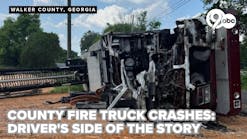This column is a component of VFIS' "Operation Safe Arrival" initiative, aimed at heightening safety awareness and reducing the frequency and severity of accidents involving emergency vehicles.
Wail, Yelp, Wail, Yelp, a little air horn here, a little air horn there, and yet the emergency services are still often confronted with the inability to safely and adequately navigate through traffic. This all too familiar theme is played out thousands of times a day across North America. Even with the many risk control technologies that exist to aid the emergency responder with safe passage, there is no guarantee of safe passage. This article takes a snap shot view of traffic preemption and its contribution to safe driving and ultimately safe passage at intersections.
Although human factors are perhaps the greatest issue surrounding many actions taken by drivers operating an emergency vehicle, intersection preemption as an engineering control has demonstrated great efficiency and effectiveness to aid pertinent safety objectives. After all, the ultimate goal is to arrive safely at the incident scene.
Traffic Preemption Systems
To preempt, according to Webster's Dictionary, is to seize upon to the exclusion of others. Thus preemption is defined as taking possession before others. Preemption in the context of this topic is simply a traffic management system. Traffic preemption systems are a form of intelligent transportation technology mounted on traffic signal devices intended to control traffic flow in the emergency vehicles direction of travel. A variety of preemption systems exist ranging from early radio based systems to strobe and sound based systems. The important point is to understand that traffic signal preemption is a communications system that allows preemption-equipped vehicles to change traffic flow through the operation of preemption-equipped traffic signals for the safe and timely passage of the emergency vehicle.
In a 1996 research project by Chief Wayne Martin of the Oviedo Florida Fire-Rescue Department, he deduced that to reduce the number of emergency vehicle related crashes at intersections, it is imperative that the use of preemption systems with a reduced light and siren response policy is needed and will save lives. Chief Martin states that of the services surveyed, 66.66% agreed that if the journey to an emergency scene could be made safer while improving or maintaining response time, they would be willing to shut off their emergency warning devices. Although this article does not address the use of lights and sirens, the results of Chief Martin's study demonstrate that such belief can promote safe vehicle operation in the emergency service organization.
Scenario
Let's review a typical scenario using traffic preemption. Note: Many preemption products with various options exist. This scenario is not intended to be representative of any particular product.
- An ambulance is dispatched to an emergency.
- The ambulance is equipped with multiple emergency warning lights and a siren.
- The ambulance is also equipped with a preemption transmitter, that during operation is a high intensity forward-facing strobe light which flashes at a rapid rate - much faster than normal attention-getting lights on the fire truck.
- When the ambulance approaches within 1800 feet (line-of-sight) of a preemption-equipped traffic signal controlled intersection, the preemption detector (normally mounted on the cross-arm that suspends the traffic signal) "sees" the ambulance's preemption transmitter and locks onto its flashing strobe.
- Once the traffic signal "sees" the ambulance, it begins to initiate a "preemption sequence" of the actual traffic signal that is different from normal operation.
- If the ambulance already has a green light, the light will remain green. Any other direction that also has a green light (usually the opposite direction) will first get a yellow light, then red. When all of the other directions are then red, and the ambulance's direction is the only one that is green, the left turn arrow (if one exists) will illuminate and a brilliant white flood lamp mounted near the traffic signal will begin to flash. This flood lamp tells the driver of the ambulance that he/she now has control of the intersection, and right-of-way (exercising due regard).
- If the ambulance has a red light, any other direction that has a green light will transition to yellow, then red. When all the directions (including the ambulance's) are red, the traffic signal facing the ambulance will then turn green, along with the left turn arrow (if one exists), and the brilliant white flood lamp will begin to flash.
- Once the ambulance has passed through the intersection, optical communication with the preemption detector (on the traffic signal) is lost. At that time the traffic signal will default back to normal operation. Conversely, until the ambulance passes through the intersection, it will have a green light, regardless of the time duration.
- If several intersections are within the 1800 foot range of the ambulance's preemption transmitter, they will all respond accordingly to the above operational description.
It should be noted that when two or more emergency vehicles reach the intersection at one time, preemption is only given to one vehicle. This is by design and based on a first come, first served basis. There is little if any reason why all emergency response agencies cannot exercise the use of traffic preemption systems.
Drivers should be trained to recognize that if you do not have a green light and the white floodlight is not flashing - you do not have preemption. If you cannot account for all lanes of traffic (vehicular and pedestrian) then come to a complete stop! It is possible that there may be another emergency vehicle coming from another direction.
As an integral part of traffic management, preemption systems are capable of recording information such as time of day, duration of preemption, direction of travel, and effective range control. Preemption is no longer dependent on a direct line of sight for activation. Products exist that are capable of preempting around curves and corners and in most weather conditions. In addition, preemption systems can recognize whether the activating vehicle is an ambulance, fire truck, or police cruiser.
Getting Started
First, conduct a risk assessment. Simply put, is there a need to preempt? Next, the response agency(agencies) needs to determine which traffic signals require preemption. Then a determination needs to be made on what travel direction(s) to preempt. Traffic pole preemption devices can address one or multiple directions. Your department may need any variation of controls depending on use frequency. Consider this, do your response vehicles always or mostly travel in any particular direction at any given intersection? Obviously, this can be different at every intersection. The next consideration is what vehicles to preempt? Modern preemption systems require an activator in each vehicle. Do all your vehicles need to preempt? Finally, the agency should educate its personnel and the general public regarding the purpose and use of preemption.
Summary
Preemption is only another tool for safe passage through an intersection. It does not give the emergency services total right-of-way. Emergency vehicle operators must exercise due regard for the safety of everyone regardless of the situation. Implementation costs vary, but the overall cost has been demonstrated to pay for itself time and again. After all, consider the internal and external impact of just one emergency vehicle collision versus all the possible collisions that never occurred. Need money? Check out the Federal Transportation Equity Act or TEA-21. The time saved through the use of traffic preemption systems is a key component, not speed, when it comes to saving lives.
For more information check out:
Related Articles:
- Don't Become A Statistic
- Developing Procedures For Emergency Vehicle Response
- Safe Intersection Practices
- Responding In Personal Vehicles
- What's Your Speed Limit?
- Lights, Sirens...Action!
- Emergency Vehicle Driver Training: More Important Than Ever
- Selecting Emergency Vehicle Drivers
- Taking Control of Traffic - Electronically
- Emergency Vehicles and Intersections: Educating the Public
- Event Data Recorders - The "Black Box" for Safer Response
- VFIS Operation Safe Arrival Website





